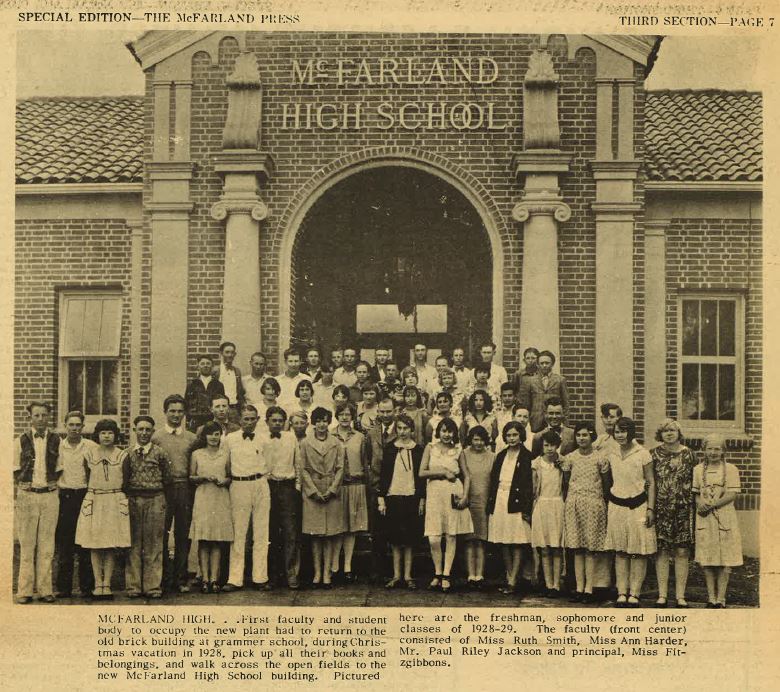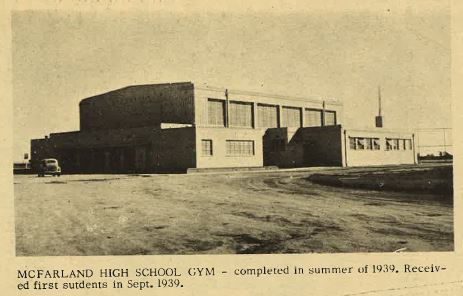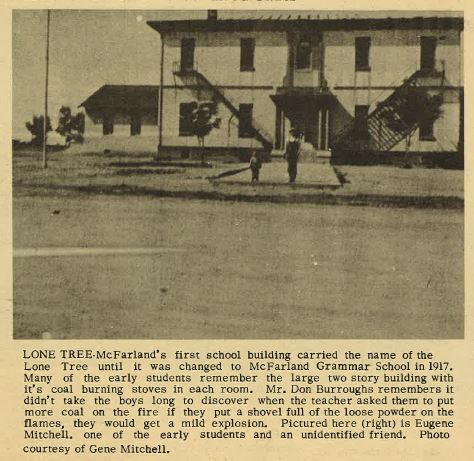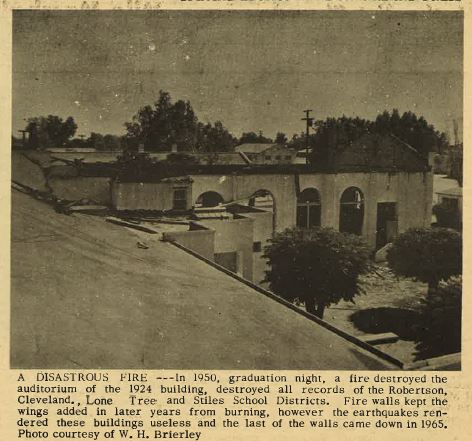History of the McFarland Unified School District

In 1874, the Central Pacific Railroad extended its tracks from Delano to Sumner, east of Bakersfield, and in the process built a siding a few miles south of Delano that came to be called Hunt, or Hunt’s Siding, and, sometimes, Lone Pine. Settlers soon began arriving in the area around Hunt’s Siding to claim twenty or forty acre parcels that had been acquired through a real estate syndicate in Los Angeles. Within a few years some fifty families and a host of stock pens were clustered around this remote railroad siding, forming a community that came to be known as the McFarland Colony. Initially there was but little commercial development in the colony and for several years the nearest source for supplies was the general store at Famoso, six miles to the south.
The principal occupation among McFarland’s early settlers was, of course, farming, and, odd as it may seem almost one hundred years later, the cultivation of roses on a commercial scale was one of the more popular agricultural ventures. A reported 180,000 cuttings were planted in 1909.
McFarland was named for James Boyd McFarland, a school teacher in Zanesville, Ohio, before coming to California around the turn of the century. He first settled in Anaheim where he operated a walnut orchard and it was during this time that he became interested in real estate development. He visited northern Kern County in 1907 and was impressed with the way crops grew in the area around Hunt’s Siding.
Shortly thereafter he moved to Kern County and enlisted the services of William Laird, a prominent real estate businessman in Bakersfield. With Lairds help, McFarland purchased the property and laid out the townsite that would soon come to bear his name.
In March of 1909, the original McFarland townsite map was filed with the Kern County Recorders Office and, with that, what had been Hunt’s Siding became the town of McFarland. By 1914 the new little town had one hundred pumping plants, a new railroad station, a 202 creamery, an ice plant, two churches, a school, and a population of some three hundred souls.
McFarland was a talented man with diverse interests. Taking advantage of the shallow water table, he became one of the first individuals to raise alfalfa using an irrigation
One of the first school districts to be established in the McFarland area, and the one destined to evolve into the present McFarland Unified School District, was called the Lone Tree School District. Formed in 1889, the first Lone Tree schoolhouse was built on the corner of Elmo Highway and Browning Road. It was later moved to a site about one mile north of present day McFarland and west of the Southern Pacific tracks, on Garzoli Avenue and Peterson Road. The school was named Lone Tree simply because at the time a solitary eucalyptus tree was the only land mark on the plains between Delano and Bakersfield. The little oasis was a welcome sight during the hot, dry months and the schoolhouse was built next to the large tree so as to take advantage of the shade that it offered.
Lone Tree began with about ten students and remained quite small for the first twenty years of its existence. The reported ADA for the 1908-09 school year was 27 pupils but with the establishment of the McFarland colony in 1908, Lone Tree’s enrollment began to climb and, by 1917, one hundred twenty-two students were in attendance. That same year the name was changed to McFarland School District.
An article from an April, 1914, edition of The Bakersfield Californian described the McFarland elementary school in these words: McFarland district grammar school is the pride of the colony as it is a brick structure of modern architecture, neat and commodious in every way, an attractive place where the youth of the district have the best of opportunities for schooling. Built at a cost of $11,000, it contains four rooms with arrangements for converting the second floor into an auditorium. Four teachers are employed and 100 pupils are enrolled.
The McFarland Union School District was formed on April 26, 1921, with the consolidation of the McFarland School District and Stiles School District. The Stiles district had been formed in February of that year and had elected a board of trustees but no school was ever built nor classes held prior to the unionization. Just months after its establishment, the McFarland Union district expanded its boundaries again through the annexation of two other small districts in the area - the Robertson School District on May 31, 1921, and the Homestead School District two months later, on the first day of August. A few years later, in May of 1930, the McFarland district once again expanded its territory with the annexation of the Cleveland School District.
The Robertson School District had been formed in 1888. The schoolhouse, which later burned down, was located at the intersection of Phillips and Zachary roads, about five miles southeast of McFarland. In its first year, 1888-89, the Robertson School had an enrollment of twenty two students, the most it would have during its brief existence. Average daily attendance dropped to twelve students in 1920-21 and the following year Robertson was absorbed by McFarland.
The Homestead School District, which included territory covering the western half of the present McFarland Unified School District as well as small portions of the present Standard, Beardsley, and Delano Union districts, had been formed in February of 1912. In its first year, 1912-13, Homestead had an average daily attendance of seven pupils. Enrollment in the district peaked at twenty-one students in 1914-15 but by 1920 had fallen to just five students. It was declared lapsed at that time and joined the McFarland Union School District the following year.
The last of McFarland’s antecedent districts was the Cleveland School District. Formed in 1889 and named for an early settler in the area, M.W. Cleveland, the Cleveland district schoolhouse was located just east of Famoso Junction, the tiny settlement where Highway 46 intersects with Highway 99. The original school was destroyed by fire in 1909 but replaced the following year with a brick structure which, although not occupied during that entire time, remained standing for more than 90 years. In its first year, 1889-90, the Cleveland district had an enrollment of sixteen students. Enrollment peaked at twenty-one students in 1920-21 but had fallen to just fifteen students in 1929-30, the year before it, too, became a part of the McFarland Union School District. Hoping to generate funds for construction of a new elementary school, the McFarland district held a bond election in 1959 but the issue failed to pass. 
Final approval of McFarland’s plan for unification rested with the State Board of Education and district trustees asked for the support of the State Department of Education in the form of a recommendation to the State Board favoring the McFarland unification plan. That support was not forthcoming, however, and unification was forestalled. Nonetheless, the McFarland trustees felt that the community should be allowed to determine the educational needs of all its youngsters, grades K through 12, particularly since their large and growing Hispanic population presented educational challenges best addressed at the local level.
A hearing on the district’s unification proposal was delayed pending the outcome of a lawsuit challenging state’s authority to require a county master plan for school district organization, a matter that was resolved in August of 1977. On September 20, 1977, the Kern County Committee on School District Organization agreed to submit McFarland’s unification proposal to the State Board of Education but the matter would not be given formal consideration by that board until July 13, 1978. The State Board of Education, overruling the staff of the State Department of Education, voted to approve the plan. In a special election held on March 6, 1979, the school reorganization proposal was approved by local voters, the final step required for unification. A second election was then held in June of 1979 to choose trustees for the newly formed district and the McFarland Unified School District began full operations on July 1, 1980.
The average daily attendance that first year as a unified school district, 1980-81, was 1,785 pupils. Since the unification of the McFarland schools in 1980, McFarland High School has gained prominence as a cross county powerhouse.

As of May 03, 2016; the McFarland Unified School District has an enrollment of: 3526 students; 1804 Males and 1722 Females, distributed in 7 schools.




